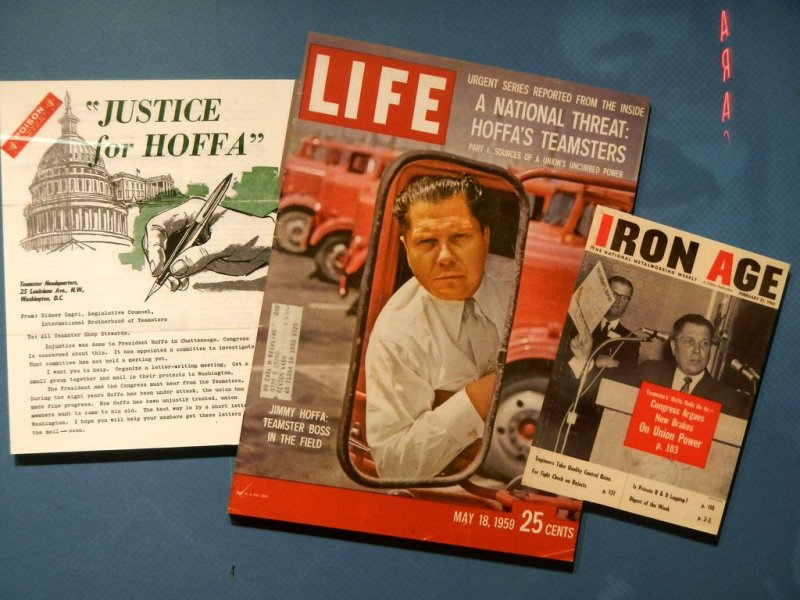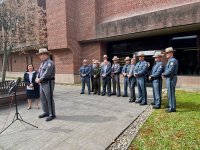There were only 14 horses at Saratoga Racecourse in late July of 1961. By that time, it was expected that at least 200 would have arrived for the racing season. Strikes led by Jimmy Hoffa and a branch of his Teamster Union, Local 917, halted the transportation of horses from New York City to Saratoga Springs. Teamsters wanted to force themselves into a position of being representatives in labor negotiations for approximately 1200 backstretch workers at Belmont and Aqueduct racecourses. Picket lines consisting of these workers formed outside the racetracks and Teamster truck drivers were ordered not to cross. No horses were to be delivered until better pay and improved working conditions were granted to the workers.
Horse owners, who normally decides wages for the workers, refused to negotiate with the Teamsters and were stuck in a difficult position. Who was going to bring their horses to Saratoga Springs? They could have found different trucks and drivers, but increased violence in the picket lines kept them from doing so. A stabbing occurred on July 22, which involved both union and non-union workers. That same day, a van operated by non-union drivers was pelted with rocks as it attempted to deliver horses to Aqueduct. The risk involved with crossing the picket lines was too great and deterred horse owners from employing any outside help for the job.
During the days that followed, the strikes and picketing continued while negotiations between Teamsters and the State Labor Board remained at a standstill. Consequently, horses were not being delivered at a rate that would ensure races could proceed as scheduled. With about a week until opening day, the entire racing season was put into question. Tension began mounting as this news spread and the Mayor of Saratoga Springs, James Benton, reached out to anyone who could help aid the situation. Among others, he was communicating with the State Labor Board, the Chamber of Commerce, the State Mediation Service, Lieutenant Governor Malcolm Wilson, and Governor Rockefeller. Everyone he spoke to assured him that racing would proceed as scheduled. These assurances were difficult to get behind though since negotiations between Teamsters and Labor Board representatives were making no progress.
Perhaps trying to circumvent these complications, Benton went straight to the top and spoke with Jimmy Hoffa on July 25. Aside from his role as mayor, Benton was the owner of the Grand Union Motel on South Broadway and was involved in many city projects. His ultimate concern was for the city and understood that its livelihood depended on business generated during the 24-day racing season. Hoffa was also aware of this and used it to his advantage. He made it clear he would only transport horses once labor demands were met. Benton suggested that Hoffa allow his drivers to move the horses and resume strikes in Saratoga, but Hoffa remained obstinate and rejected any pleas or compromises presented to him.
In the meantime, plans for using trains to move the horses had been quietly formulated. Trains were an outdated method of transportation at that point, but the equipment needed for the task was still available. The New York Racing Association employed “special cars,” for the use of transporting horses and, on July 26, D&H Railroad was seen putting up a “horse siding,” at their West Circular Street depot. The trains were to be routed through Connecticut and Massachusetts before coming to New York. Changes made to the railways in recent years prevented the special train cars from clearing certain bridges, so this indirect route had to be taken.
On July 27, the first bulk of horses arrived successfully. As early as 5 a.m., 60 people gathered outside the D&H depot to watch the horses unload and parade their way to the stables. In a way, this was reviving an old tradition, albeit against the will of the city. Back when horses were normally brought by rail, people would gather to watch as they were unloaded and then guided across Broadway and down Union Avenue to the racecourse. The event was symbolic of mid-summer and assured citizens that the city would soon be booming. A total of 3 trains and 8 vans arrived between 3 a.m. until around noon that day, bringing a total of over 100 horses. The vans were able to make the trip undisturbed thanks to protection given along the way by state police, city police, local sheriffs, and Pinkerton Security.
The operation continued into July 28 and approximately 400 more horses arrived. This shift in momentum, from no horses to suddenly over 500 horses delivered in 2 days, coincided with a break in the Teamsters’ position. A spokesman for the Eberts Van Co., one of the major horse transporters that was previously honoring the picket lines, said that 6 of his 7 drivers went back to work. It’s likely that with little headway being made with negotiations, drivers chose to resume work and not completely lose out on money. The next few days were relatively peaceful, and Saratoga Springs continued to receive horses uninterrupted.
On July 31, opening day at Saratoga Racecourse, the front page of The Saratogian announced, “Fans, Horses, Stream to Racetrack.” With nearly 1300 horses on the grounds and over 12,000 people attending, races proceeded as usual that day. Threats of pickets and strikes coming to Saratoga Springs were revealed to be harmless. Only a handful of picketers were seen outside the gates of the track that morning. Even though labor disputes would continue through the following months, they would never reach the level they did during the week leading up to opening day.
Special thanks to Chris and Larry Benton for telling me stories about their father, Mayor James Benton, and offering their insight regarding the lead up to the 1961 racing season.
Matt Bonk graduated from SUNY Albany in 2019 with a bachelor’s degree in History and is currently working at Brookside Museum in Ballston Spa as a museum assistant and has recently curated the new exhibit “A Saratoga Family Tale.”






































